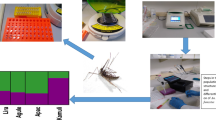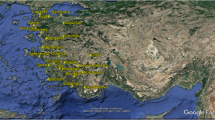Abstract
The number of Anopheles gambiae and Anopheles arabiensis females that used each of the 33 sampled breeding sites in west Kenya was estimated by microsatellite markers and related statistics to test the hypothesis that conspecific females share aquatic sites. Totally, 166 An. gambiae and 168 An. arabiensis larvae were identified and were genotyped. The mean number of larvae per breeding site was 8.3 for An. gambiae and 8.4 for An. arabiensis. The likelihood method estimated that, for An. gambiae, the mean number of females that would have laid eggs per breeding site was 5.2 and ranged from 2 to 9, and for An. arabiensis, the mean was 5.0 with a range of 2–10. The clustering method estimated that the mean number of females laying eggs per breeding site was 6.8 for An. gambiae. The results provide molecular evidence that females of one or both species share breeding sites.


Similar content being viewed by others
References
Apostol BL, Black WC IV, Miller BR, Reiter P, Beaty BJ (1993) Estimation of the number of full-sibling families at an oviposition site using RAPD-PCR markers: applications to the mosquito Aedes aegypti. Theor Appl Genet 86:991–1000
Apostol BL, Black WC IV, Reiter P, Miller BR (1994) Use of ramdomly amplified polymorphic DNA amplified by polymerase chain reaction markers to estimate the number of Aedes aegypti families at oviposition sites in San Juan, Puerto Rico. Am J Trop Med Hyg 51:89–97
Blouin MS, Parsons M, Lacaille V, Lotz S (1996) Use of microsatellite loci to classify individuals by relatedness. Mol Ecol 5:393–401
Chadee DD, Corbet PS (1987) Seasonal incidence and diel patterns of oviposition in the field of the mosquito, Aedes aegypti (L.) (Diptera: Culicidae) in Trinidad, West Indies: a preliminary study. Ann Trop Med Hyg 81:151–161
Chadee DD, Corbet PS, Greenwood JJD (1990) Egg-laying yellow fever mosquitos avoid sites containing eggs laid by themselves or by conspecifics. Entomol Exp Appl 57:295–298
Chen H, Minakawa N, Beier J, Yan G (2004) Population genetic structure of Anopheles gambiae mosquitoes on Lake Victoria islands, west Kenya. Malaria J 3:48
Chen H, Fillnger U, Yan G (2006a) Oviposition behavior of female Anopheles gambiae in western Kenya inferred from microsatellite markers. Am J Trop Med Hyg 75:246–250
Chen H, Githeko AK, Zhou G, Githure JI, Yan G (2006b) New records of Anopheles arabiensis breeding on the Mount Kenya highlands indicate indigenous malaria transmission. Malaria J 5:17
Coetzee M, Craig M, Le Sueur D (2000) Distribution of African malaria mosquitoes belonging to the Anopheles gambiae complex. Parasitol Today 16:74–77
Colton YM, Chadee DD, Severson DW (2003) Natural skip oviposition of the mosquito Aedes aegypti indicated by codominant genetic markers. Med Vet Entomol 17:195–204
Donnelly MJ, Townson H (2000) Evidence for extensive genetic differentiation among populations of the malaria vector, Anopheles arabiensis in East Africa. Insect Mol Biol 9:357–367
Gillies MT, Coetzee M (1987) A supplement to the Anophelinae of Africa south of the Sahara. S African Inst Med Res 55:1–143
Goodnight KF (2001) Kinship 1.2 Manual. Dept. of Ecol. and Evolutionary Biol., Rice University, Houston, TX
Gwadz R, Collins FH (1996) Anopheline mosquitoes and the agents they transmit. In: Beaty BJ, Marquardt WC (eds) The biology of disease vectors. University Press of Colorado, Colorado, pp 73–84
Harrington LC, Edman JD (2001) Indirect evidence against delayed “skip-oviposition” behavior by Aedes aegypti (Diptera: Culicidae) in Thailand. J Med Entomol 38:641–645
Huang J, Walker ED, Giroux PY, Vulule JM, Miller JR (2005) Ovipositional site selection by Anopheles gambiae: influences of substrate moisture and texture. Med Vet Entomol 19:442–450
Huang J, Miller JR, Chen S, Vulule JM, Walker ED (2006) Anopheles gambiae (Diptera: Culicidae) oviposition in response to agarose media and cultured bacterial volatiles. J Med Entomol 43:498–504
Kamau L, Hawley WA, Lehmann T, Orago AS, Cornel A, Ke Z, Collins FH (1998) Use of short tandem repeats for the analysis of genetic variability in sympatric populations of Anopheles gambiae and Anopheles arabiensis. Heredity 80:675–682
Kamau L, Mukabana WR, Hawley WA, Lehmann T, Irungu LW, Orago AA, Collins FH (1999) Analysis of genetic variability in Anopheles arabiensis and Anopheles gambiae using microsatellite loci. Insect Mol Biol 8:287–297
Lehmann T, Hawley WA, Kama L, Fontenille D, Simard F, Collins FH (1996) Genetic differentiation of Anopheles gambiae populations from East and West Africa: comparison of microsatellite and allozyme loci. Heredity 77:192–208
Lehmann T, Licht M, Gimnig JE, Hightower A, Vulule JM, Hawley WA (2003) Spatial and temporal variation in kinship among Anopheles gambiae (Diptera: Culicidae) mosquitoes. J Med Entomol 40:421–429
Lindsay SW, Parson L, Thomas CJ (1998) Mapping the ranges and relative abundance of the two principal African malaria vectors, Anopheles gambiae sensu stricto and An. arabiensis, using climate data. Proc R Soc Lond Series B 265:847–854
McCrae AWR (1983) Oviposition by African malaria vector mosquitoes I. Temporal activity patterns of caged, wild-caught, freshwater Anopheles gambiae Giles sensu lato. Ann Trop Med Parasitol 77:615–625
McCrae AWR (1984) Oviposition by African malaria vector mosquitoes II. Effects of site type, water type and conspecific immatures on target selection by freshwater Anopheles gambiae Giles sensu lato. Ann Trop Med Parasitol 78:307–318
Minakawa N, Mutero CM, Githure JI, Beier JC, Yan G (1999) Spatial distribution and habitat characterization of anopheline mosquito larvae in western Kenya. Am J Trop Med Hyg 61:1010–1016
Minakawa N, Githure JI, Beier JC, Yan G (2001) Anopheline mosquito survival strategies during the dry period in western Kenya. J Med Entomol 38:388–392
Minitab (1996) Minitab Reference Manual, Version 12.2. Minitab, Pennsylvania
Nyanjom SRG, Chen H, Gebra-Micheal T, Bekele E, Shililu J, Githure J, Beier JC, Yan G (2003) Population genetic structure of Anopheles arabiensis mosquitoes in Ethiopia and Eritrea. J Heredity 94:457–463
Pates H, Curtis C (2005) Mosquito behavior and vector control. Ann Rev Entomol 50:53–70
Queller DC, Goodnight KF (1989) Estimating relatedness using genetic markers. Evolution 43:258–275
Rohlf FJ (2000) NTSYSpc User Guide, Version 2.1. Applied Biostatistics Inc., New York
Schneider P, Takken W, McCall PJ (2000) Interspecific competition between sibling species larvae of Anopheles arabiensis and An. gambiae. Med Vet Entomol 14:165–170
Scott JA, Collins BWG (1993) Identification of single specimens of the Anopheles gambiae complex by the polymerase chain reaction. Am J Trop Med Hyg 49:520–529
Simard F, Fontenille D, Lehmann T, Girod R, Brutus L, Gopaul R, Dournon C, Collins FH (1999) High amounts of genetic differentiation between populations of the malaria vector Anopheles arabiensis from West Africa and Eastern outer islands. Am J Trop Med Hyg 60:1000–1009
Taylor CE, Toure YT, Coluzzi M, Petrarca V (1993) Effective population size and persistence of Anopheles arabiensis during the dry season in West Africa. Med Vet Entomol 7:351–357
Tripet F, Toure YT, Taylor CE, Norris DE, Dolo G, Lanzaro GC (2001) DNA analysis of transferred sperm reveals significant levels of gene flow between molecular forms of Anopheles gambiae. Mol Ecol 10:1725–1732
Vaughan JA, Noden BH, Beier JC (1994) Sporogonic development of Plasmodium falciparum in six species of laboratory-infected Anopheles mosquitoes. Am J Trop Med Hyg 51:233–243
Wagbatsoma VA, Ogbeide O (1995) Towards malaria control in Nigeria: a qualitative study on the population of mosquitoes. J R Soc Health 115:363–365
Zheng L, Benedict MQ, Cornel AJ, Collins FH, Kafatos FC (1996) An integrated genetic map of the African human malaria vector mosquito, Anopheles gambiae. Genetics 143:941–952
Acknowledgements
We thank Dr. D. Amenya and two anonymous reviewers for their valuable comments on the manuscript. This research was supported by Sumitomo Foundation, UNDP/WORLD BANK/WHO Special Programme for Research and Training in Tropical Diseases (TDR), and NIH grants D43 TW01505, U19 AI45511 and R01 AI50243.
Author information
Authors and Affiliations
Corresponding author
Rights and permissions
About this article
Cite this article
Chen, H., Minakawa, N., Cui, L. et al. Conspecific Sharing of Breeding Sites by Anopheline Female Mosquitoes (Diptera: Culicidae) Inferred from Microsatellite Markers. J Insect Behav 21, 24–33 (2008). https://doi.org/10.1007/s10905-007-9101-4
Revised:
Accepted:
Published:
Issue Date:
DOI: https://doi.org/10.1007/s10905-007-9101-4




